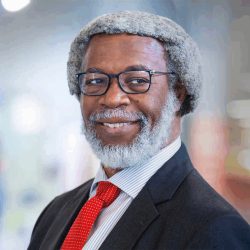College Faculty Members Honored as 2024 Invention of the Year Awardees
The University of Maryland celebrates innovative campus research annually by recognizing Inventions of the Year. Since 1987, 116 inventions have been awarded the high distinction, selected for their technical merit, improvements to existing technology, commercial potential and overall benefit to society.
The 2024 winners were announced on April 29, 2024, as part of Innovate Maryland—an annual celebration of UMD researchers’ creativity in translating cutting-edge research into practical, impactful solutions to address global challenges.
“Each of tonight’s nominees for Invention of the Year started with that spark of an idea that was allowed to grow and evolve with the help of our robust research enterprise, which we all contribute to and improve on a daily basis,” Vice President for Research Gregory F. Ball said of this year’s 12 finalists. “I firmly believe that no grand challenge is too daunting for our world-class researchers to confront head-on and work toward a solution.”
Below are the 2024 Invention of the Year Award honorees from the College of Computer, Mathematical, and Natural Sciences.
Information Sciences Invention of the Year: Binoculars: A Method for Detecting Text Generated by Large Language Models
Two years ago, the launch of ChatGPT kicked off an AI boom that has been making headlines ever since. The growth of AI—specifically of large language models (LLMs) like ChatGPT—has been felt across all industries, but raises concerns about plagiarism, fraud and disinformation. Recent attempts to detect LLM-generated content have been consistently found unreliable, but Tom Goldstein, a Volpi-Cupal Family Endowed Professor in the Department of Computer Science, computer science graduate student Abhimanyu Hans and Avi Schwarzschild (Ph.D. ’23, applied mathematics & statistics, and scientific computation) developed an accurate method for distinguishing human-generated content. The method, dubbed “Binoculars,” does not require any training data and does not need to modify the LLM to detect AI-generated text. It is also more reliable than many of its predecessors, with an accuracy rate of 90% and a false positive rate of 0.01%.
Quantum Invention of the Year: Quantum Non-Demolition Photon Counter
The rise of quantum computing presents unprecedented opportunities, leveraging the laws of quantum mechanics to tackle challenges beyond classical computers’ reach. Challenges to quantum computing have led researchers around the world to turn to the use of photons, or tiny particles of light, that can carry information from one place to another. With this development, photon counting has become a vital part of the field. Traditional methods of photon counting destroy the particles’ quantum states, and existing attempts to circumvent this have a number of limitations. Researchers in the Department of Physics and the National Institute of Standards and Technology (NIST)—NIST physicist and Adjunct Professor Alexey Gorshkov, NIST physicist and Adjunct Assistant Professor Michael Gullans, NIST Research Scientist James “Trey” V. Porto, graduate student Christopher Fechisin, current IBM Research Scientist Kunal Sharma, current Amazon Web Services Research Scientist Przemyslaw Bienias and Department of Physics Chair Steven Rolston have developed a new protocol that eliminates these limitations. Unlike previous methods, the researchers’ protocol has no fundamental limitation on the number of photons being counted and has the ability to count itinerant—or moving—photons. Their work has potential applications in light detection and ranging (LIDAR), fiber optic communication, quantum information processing, quantum encryption and cybersecurity, medical imaging, DNA sequencing and astrophysics.
Life Sciences Invention of the Year Finalist: An Accelerated Cellular Model for Alzheimer’s Disease
Lamin A is a key component of the nuclear lamina. Progerin, a truncated protein resulting from specific lamin A mutations, causes Hutchinson-Gilford Progeria Syndrome (HGPS), a disease that prematurely ages individuals. Kan Cao, professor in the Department of Cell Biology and Molecular Genetics, and Huijing Xue (Ph.D. ’23, biological sciences) investigated the effects of exogenous progerin expression on neural progenitor cells carrying familial AD mutations (FAD). Within three to four weeks of differentiation, these cells exhibited robust AD phenotypes. Additionally, progerin expression significantly increased AD cellular phenotypes such as cell death and cell cycle re-entry. These results suggest that progerin expression could be used to create an accelerated model for AD development and drug screening.
Physical Science Invention of the Year Finalist: Novel Synthesis Process for Production of New Grade Polymers
Lawrence Sita, professor in the Department of Chemistry and Biochemistry, Danyon Fischbach (Ph.D. ’23, chemistry) and Charlotte Wentz (Ph.D. ’22, chemistry) developed a new method using specialized tools to modify a type of plastic called Poly(4-methyl-1-pentene) (PMP). This method helps alter the structure of PMP, allowing for the creation of new forms of the material with adjustable properties like how they transition from solid to liquid states. Some mixtures of metal compounds produce a blend of PMP with varying structures, making it more flexible and changing the temperatures at which it melts. Another mixture produces a specific type of PMP that doesn't form crystals, making it easier to work with. The researchers have also developed a process that can control the level of errors in the structure of the PMP, which enables PMP with different melting temperatures ranging from 135°C (275°F) to 226°C (428°F), while still maintaining specific characteristics like its glass transition temperature. These new types of PMP can be used to make products that can be recycled alongside regular plastics like polyethylene and polypropylene. They can also be used to improve existing products, like making them less likely to break or crack. In short, this invention makes it possible to recycle PMP alongside other common plastics and opens up new possibilities for creating stronger and more versatile products.







